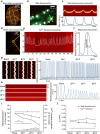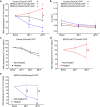SERCA is critical to control the Bowditch effect in the heart
- PMID: 30127403
- PMCID: PMC6102201
- DOI: 10.1038/s41598-018-30638-9
SERCA is critical to control the Bowditch effect in the heart
Abstract
The Bowditch effect or staircase phenomenon is the increment or reduction of contractile force when heart rate increases, defined as either a positive or negative staircase. The healthy and failing human heart both show positive or negative staircase, respectively, but the causes of these distinct cardiac responses are unclear. Different experimental approaches indicate that while the level of Ca2+ in the sarcoplasmic reticulum is critical, the molecular mechanisms are unclear. Here, we demonstrate that Drosophila melanogaster shows a negative staircase which is associated to a slight but significant frequency-dependent acceleration of relaxation (FDAR) at the highest stimulation frequencies tested. We further showed that the type of staircase is oppositely modified by two distinct SERCA mutations. The dominant conditional mutation SERCAA617T induced positive staircase and arrhythmia, while SERCAE442K accentuated the negative staircase of wild type. At the stimulation frequencies tested, no significant FDAR could be appreciated in mutant flies. The present results provide evidence that two individual mutations directly modify the type of staircase occurring within the heart and suggest an important role of SERCA in regulating the Bowditch effect.
Conflict of interest statement
The authors declare no competing interests.
Figures



References
-
- Bowditch HP. Über die Eigentümlichkeiten der reizbarkeit, welche die muskelfasern des herzens zeigen. Ber. Sachs. Ges. Wiss. 1871;23:652–689.
-
- Feldman MD, Gwathmey JK, Phillips P, Schoen F, Morgan JP. Reversal of the force-frequency relationship in working myocardium from patients with end-stage heart failure. J. Appl. Cardiol. 1988;3:273–283. - PubMed
Publication types
MeSH terms
Substances
LinkOut - more resources
Full Text Sources
Other Literature Sources
Molecular Biology Databases
Miscellaneous

